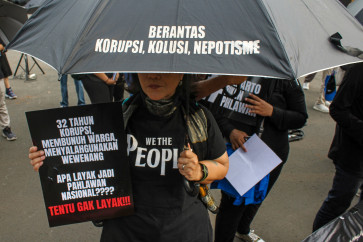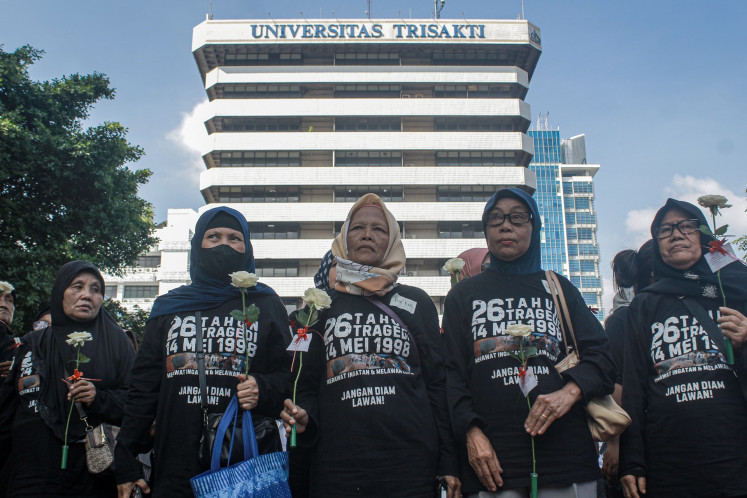GDP growth beats expectations, buoyed by domestic spending
Indonesia’s economic growth once again beat market estimates as the country’s GDP increased by 5.17 percent year-on-year in the second quarter of 2023, despite a drop in exports.
Change text size
Gift Premium Articles
to Anyone

I
ndonesia’s economic growth once again beat market estimates, with GDP rising by 5.17 percent year-on-year (yoy) in the second quarter of 2023, thanks to strong domestic demand.
Forecasts published by Bank Mandiri and Bank Permata had projected annual GDP growth of 5.04 and 5.0 percent, respectively.
“Amid a global economic slowdown and a declining trend for key commodity exports, the Indonesian economy showed solid growth at 5.17 percent yoy,” Statistics Indonesia (BPS) official Edy Mahmud announced in a press briefing on Monday.
This reading marks the seventh consecutive quarter with economic growth above 5 percent.
In a separate briefing on Monday, Coordinating Economic Minister Airlangga Hartarto said Jakarta was still aiming for full-year GDP growth of 5.3 percent, marking the upper bound of the target range set in the state budget.
“Normally, we can still push economic growth in the third quarter, and one of the prerequisites to that is we genjot [speed up] government spending,” Airlangga said.
Growth occurred in all industries, with the transportation and storage sector seeing the fastest expansion at 15.28 percent yoy.
In terms of overall expenditure, consumers still account for the lion’s share of economic activity in Indonesia.
Household spending rose by 5.23 percent in the second quarter, contributing 2.77 percentage points to the overall annual GDP increase.
General government spending jumped by 10.62 percent yoy, but its impact on the overall economy is much smaller than that of household spending.
Gross fixed capital formation, which reflects investment in fixed assets like buildings, machinery and equipment, meanwhile, rose by only 4.63 percent.
Unlike the previous few quarters, when the archipelago’s economic growth was heavily supported by net exports, the latest quarter saw net exports drag down the GDP growth figure by 0.04 percentage points.
Net exports are the sum of all exports of goods and services minus all imports. Total exports dropped 2.75 percent yoy in the second quarter, largely due to lower exports from the mining sector, which accounts for some 70 percent of total national exports, according to the BPS data, while imports declined 3.08 percent.
Overseas sales of crude palm oil (CPO), another vital export commodity for Indonesia, plummeted by 26.72 percent in the second quarter.
That comes despite an increase of 5.16 percent yoy of Indonesia’s CPO export volume, as the global market price for the commodity was down a massive 43.76 percent yoy in the second quarter.
Airlangga said that palm oil would remain one of Indonesia’s main commodities, but the export performance depended on global commodity prices that had been coming back down after the 2021-2022 windfall.
“Commodity prices are now near normal, and, of course, with normal prices, what we will jack up is the volume,” Airlangga said.
In addition, the government was hoping to achieve higher manufacturing sector exports by wrapping up the Indonesia-EU Comprehensive Economic Partnership Agreement (IEU-CEPA) by the end of this year, Airlangga said.
Once the IEU-CEPA is concluded, the two sides can agree to nullify import duties. To enter the EU market today, Indonesian goods are typically subject to import duty between 10 percent and 17 percent, according to the minister.
“Indonesia is a reliable supply chain [option],” said Airlangga, emphasizing why accelerating the IEU-CEPA might be beneficial for both sides.
In a quarter-to-quarter assessment, Indonesia’s economy expanded by 3.86 percent in the April-to-June period, bringing annual GDP growth in the first half of the year to 5.11 percent.
Bank Mandiri economist Faisal Rachman predicted that Indonesia’s economy would demonstrate resilience in the second half of 2023 despite headwinds from a global economic slowdown.
He elaborated that the source of Indonesia’s economic growth in the second half would continue to shift from external sources to the domestic economy.
“Export activities are projected to weaken in line with the global economic slowdown, presenting challenges for the external sector's performance,” Faisal noted in a statement released on Monday.
“In contrast, domestic consumption is expected to maintain a robust trajectory, driven by factors such as improved public mobility, a decline in inflation rates and a solid fiscal situation,” he added.
Furthermore, he explained that the government had a sound fiscal position that would allow it to accelerate spending in “pro-growth sectors and expenditure related to the preparation” for the general election.
Concurring with that, Bank Danamon economist Irman Faiz said spending on presidential campaign activities and increased fiscal budget allocations were to be expected.
“[Those will] create a multiplier effect on private consumption. This combined effect is likely to fuel further growth in consumer spending,” Irman stated in a press release on Monday.









